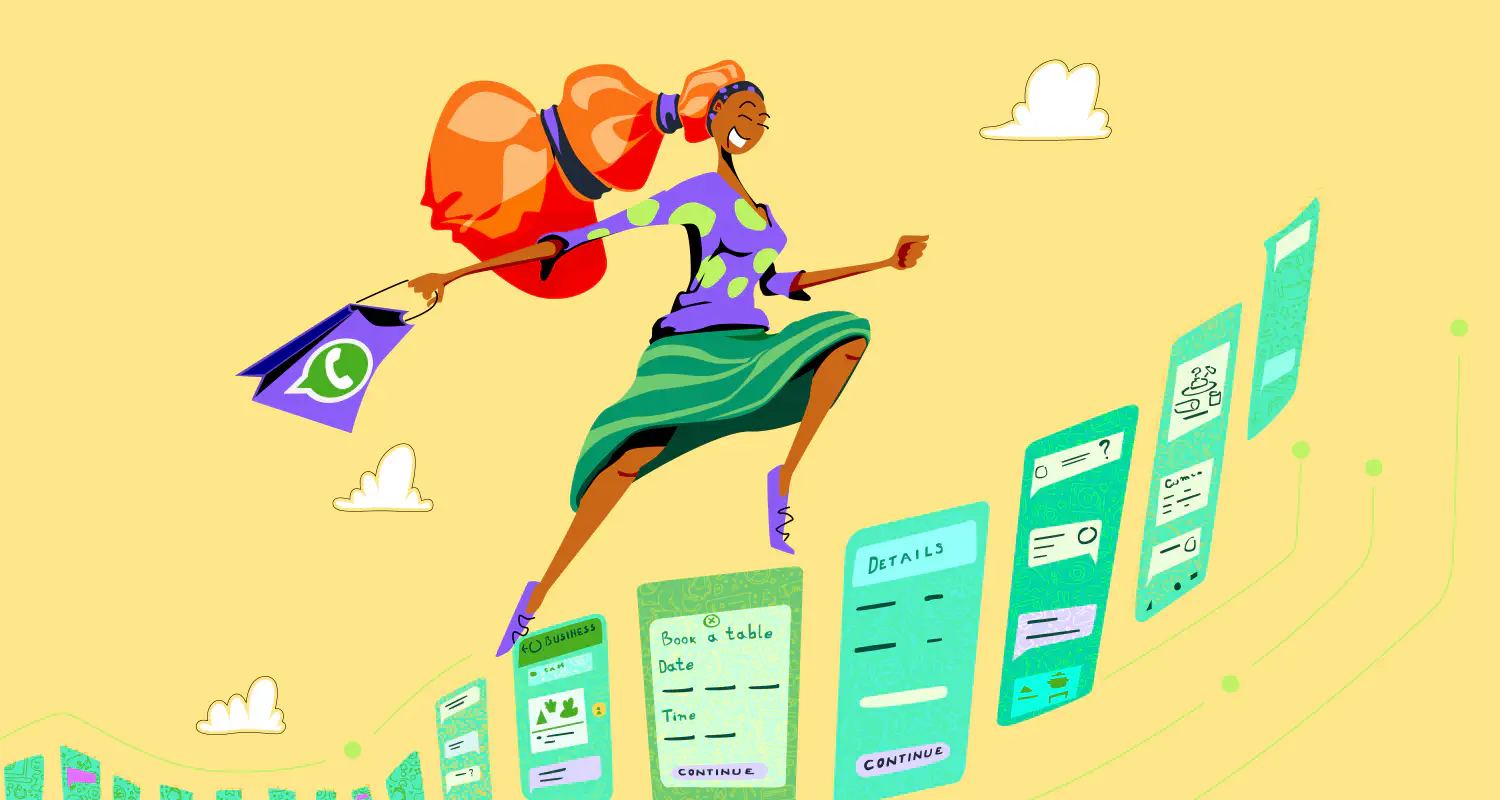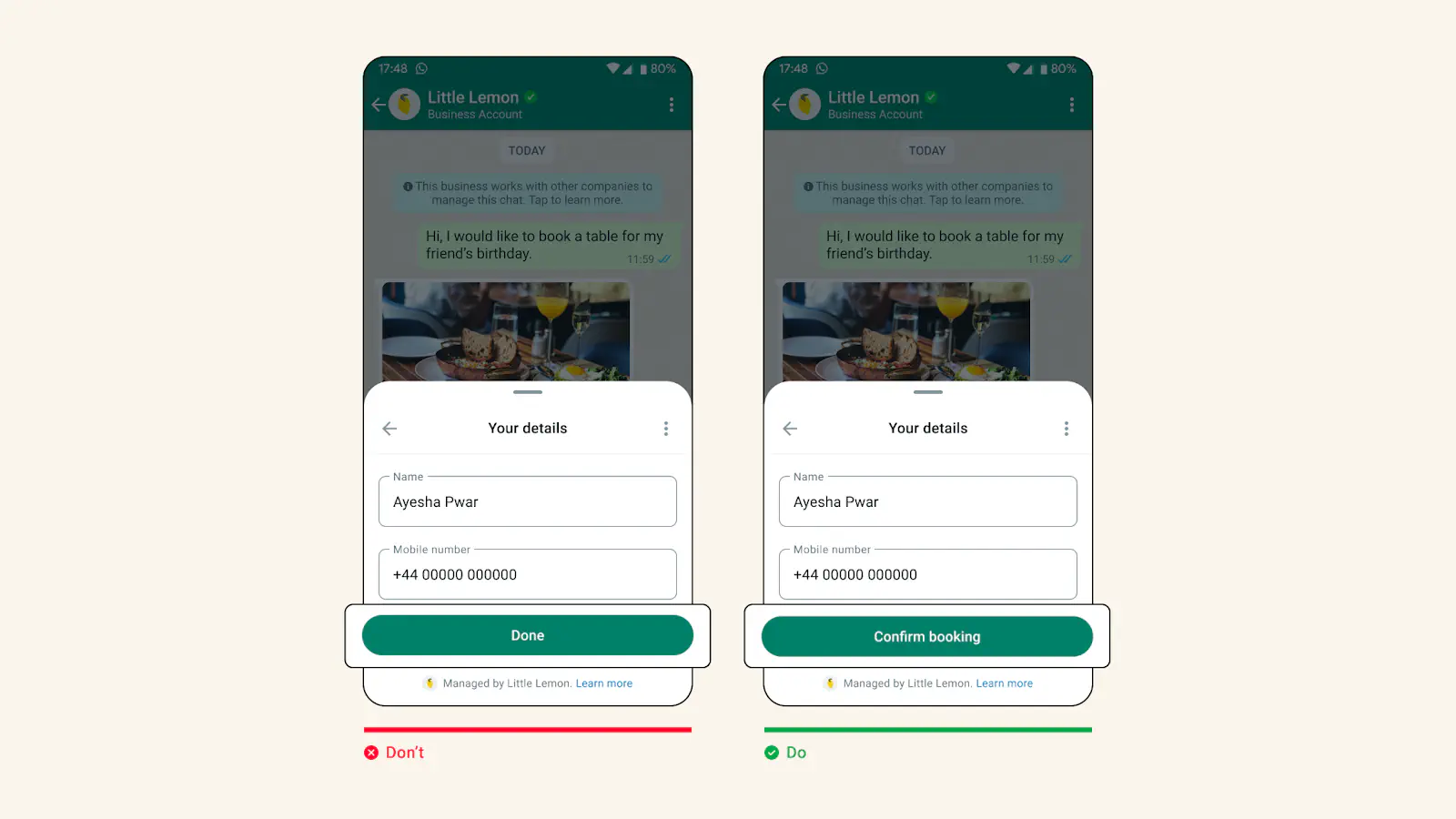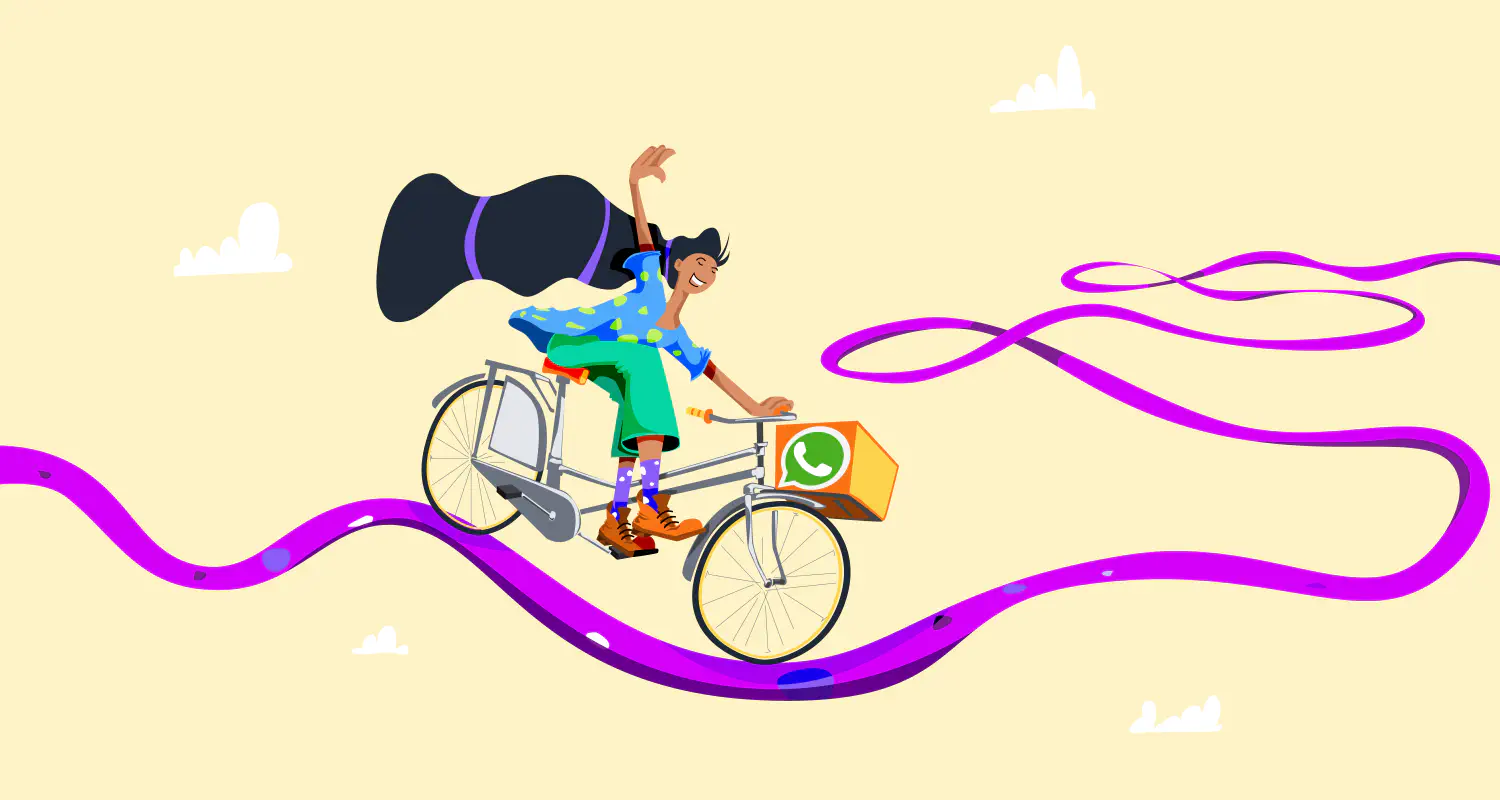WhatsApp Flows Best Practices: 7 Tips to Enhance User Experience

In an ever-evolving digital landscape, communication is at the heart of every successful business. And when it comes to communication, WhatsApp Flows has emerged as a game-changer. In our previous article, “Introducing WhatsApp Flows” we discussed the latest feature introduced by Meta and explored its potential to transform how businesses and customers interact.
Now, in this article, we take a deeper dive into WhatsApp Flows, focusing specifically on the best practices that can elevate your user experience to new heights. As businesses increasingly embrace this powerful tool, understanding and implementing these best practices becomes paramount.
When creating a flow, it’s essential to keep best practices in mind in order to craft experiences that engage your users effectively and make the most of WhatsApp’s capabilities. WhatsApp Flows offer a dynamic way to connect with your audience, providing real-time communication and personalized interactions. To help you achieve exceptional user experiences, here are some essential best practices to consider:
Best practices to create WhatsApp flows
If you strive to create a stellar user experience with WhatsApp Flows you need to have attention to detail, intuitive design, and a clear understanding of the user’s journey.
1. Enhance user-friendly interactions
- Clear call-to-actions: CTAs should be explicit about the forthcoming action, like “Confirm booking,” to manage user expectations and foster clear communication.

Source: Meta
Appropriate use of emojis: Consider if using emojis is appropriate for your communication strategy. Though seemingly trivial, emojis can heavily influence the tone of the conversation. If you use them, assess their context relevance, effect on content, and alignment with your brand persona.
Error handling: To err is human. Errors are inevitable, but mishandling them isn’t. When errors occur, inform the user about the issue and provide solutions and validation criteria. In case of data-related issues, guide users back to the previous screen instead of stopping abruptly.
2. Establish content hierarchy and clarity
Content hierarchy helps users easily understand and navigate through the flow. You can ensure a smooth user experience by using:
- Headings, body text, and captions: Headings can introduce new sections or topics, body text elaborates on details, and captions provide context or additional information.
- Concise and non-repetitive content: Ensure that your messages are clear and avoid reiterating the same information repeatedly.
3. Streamline diverging flows
Sometimes, the need for sub-flows, like a “forgot password” route, arises. Ensure that:
- Such sub-flows are compact, ideally capped at three screens.
- Post-completion, users are seamlessly redirected back to the primary task.
4. Simplify flow design
Several factors play a crucial role in enhancing the user experience. Consider the following best practices as you streamline your flows:
- Length: Lengthy flows can deter users. Aim for tasks that conclude within 5 minutes.
- Task distribution: Overloading a screen with tasks can be overwhelming. Distribute tasks across screens for clarity.
- Component utilization: An excessive number of components on a screen can clutter the visual space and increase load times. Design keeping in mind the balance and user convenience.
- Caching: Remember, post-completion of a screen, user inputs get cached. Overloading can risk data loss upon flow exit, leading to user frustration.
5. Optimize form quality
Effective form design not only enhances user experience but also ensures that information is collected efficiently. Here are some key considerations to keep in mind:
- Use components that align with the action. For instance, employ date pickers for capturing DOB.
- For extensive text inputs, opt for text area components over simple text inputs.
- Ensure questions and labels clearly convey their intent.
- Maintain a logical sequence in forms, like arranging fields in the order of first name followed by the last name.
- Non-essential forms, which aren’t critical for task completion, should ideally be optional.
6. Check for grammar, spelling and formatting
- Double-check content prior to publishing to prevent oversights.
- Maintain consistency in terms of spelling and capitalization.
- Ensure grammatical correctness down to details like full stops at sentence ends.
- Accuracy in data representation is crucial. Adhere to appropriate formats, be it currency symbols, phone numbers, or dates.
7. Leverage helper text
These are invaluable for users, acting as guidance notes. Whether it’s the proper format for phone numbers or email addresses, such text aids users in seamless data input, ensuring fewer errors and a smoother flow experience.
WhatsApp flows best practices for your business
Let’s dive into WhatsApp Flows best practices and examine how they can be applied across various industries to ensure seamless interactions, personalized engagement, and efficient communication.
Flows for eCommerce
In the realm of eCommerce, WhatsApp Flows involves creating personalized shopping experiences, real-time order management, and efficient customer support. To excel, eCommerce businesses can:
- Personalized shopping experience: Craft Flows that allow customers to customize products and receive tailored recommendations actively. By understanding user preferences, you can provide a shopping experience that keeps customers coming back for more.
- Real-time order management: Use WhatsApp Flows to handle inquiries about products, check order statuses, and provide instant responses. This fosters trust and reliability, ultimately leading to increased customer satisfaction and reduced order returns.
- Feedback and after-sales support: WhatsApp Flows provide a channel for customers to provide feedback, request returns, or seek support—all within the chat interface. This ensures post-purchase engagement and a seamless customer experience.
Flows for restaurants
Restaurants can use WhatsApp Flows to simplify the booking process and enhance the dining experience. Best practices for this industry involve implementing instant table booking, gathering dining preferences, and streamlining customer interactions. Here’s how:
- Instant table booking: WhatsApp Flows can eliminate the hassle of making phone calls or using third-party platforms for reservations. Enable customers to book, modify, or cancel reservations directly through chat, and consider allowing them to specify special dining requests or dietary restrictions beforehand.

Source: Meta
- Gathering dining preferences: Use Flows to collect and store dining preferences, ensuring that when customers return, their favorite dishes and seating arrangements are readily available.
Flows for event management
Event management businesses can leverage WhatsApp Flows to streamline registration, engagement, and feedback collection. Best practices in this industry include simplifying the registration process, keeping attendees informed, and gathering post-event insights. Here’s how to do it:
- Seamless registration process: Implement Flows that enable potential attendees to register for events without the need for external forms or websites. Simplify the process to encourage more registrations.
- Feedback Collection: Post-event, gather insights and feedback through Flows. This valuable data can help improve future events and enhance the overall attendee experience.
Flows for insurance
WhatsApp Flows can offer the insurance sector significant advantages, especially by optimizing and enhancing the claims process:
- Streamlining claims processing: Use WhatsApp Flows to guide customers through the intricate claims procedure, systematically collecting all essential information. This not only expedites the claims processing time but also significantly enhances overall customer satisfaction.
Flows for healthcare
In healthcare, WhatsApp Flows offer a streamlined approach to appointment booking:
- Effortless consultation booking: Enable patients to seamlessly book their consultations directly through chat, ensuring instant confirmations. This simplifies the process and provides patients with the assurance they need regarding their appointment date and time.
These strategies will empower your business to leverage the full potential of WhatsApp Flows for your business and stay ahead in the competitive landscape.
Measuring impact of WhatsApp flows
Once you’ve implemented the best practices for creating Flows, it’s crucial to validate your approach and measure the impact of your efforts. Here are some key performance metrics you need to monitor closely:
Engagement rates
This metric measures how users interact with your WhatsApp Flows. It can reveal valuable insights into which Flows are resonating with your audience and which might need improvement. Monitoring engagement rates helps you optimize content and design to keep users engaged throughout their journey.
Response times
The speed at which you respond to user inquiries is crucial for a positive user experience. Tracking response times ensures you’re meeting user expectations for timely assistance. Swift responses can lead to increased user satisfaction and better overall results.
Conversion rates
Conversion rates assess the percentage of users who take desired actions within your WhatsApp Flows, such as making a purchase, booking an appointment, or providing feedback. Monitoring conversion rates helps you identify bottlenecks in your Flows and optimize them to improve user outcomes.
Customer satisfaction
Collecting feedback or ratings from users is invaluable when it comes to understanding their satisfaction levels. It provides insights into what’s working well and where improvements are needed. High levels of customer satisfaction are often indicative of successful WhatsApp Flows practices.
Read our recent post if you want to learn how to measure the success of your WhatsApp marketing campaigns.
Conclusion
By implementing these best practices, you can create more user-friendly, engaging, and efficient WhatsApp Flows. Whether you seek to improve customer interactions, streamline processes, or boost engagement, these strategies provide a roadmap for success.
To get started, explore our guide on creating WhatsApp Flows using WhatsApp Manager.
We’re excited to share that soon WhatsApp Flows will be integrated into Rasayel. This integration will further simplify the process of creating and implementing WhatsApp Flows for your business. Stay tuned for this exciting development that will make harnessing the power of WhatsApp Flows even more accessible and convenient.
Frequently Asked Questions
Flows is a WhatsApp feature that allows businesses to create interactive chat pathways on WhatsApp. It’s important for businesses because it enables personalized interactions, streamlined processes, and efficient customer communication.
To design user-friendly WhatsApp Flows, keep in mind these best practices: using clear Call-To-Actions (CTAs), making thoughtful decisions about emoji use, addressing errors gracefully, maintaining a well-defined content hierarchy, avoiding unnecessary repetition, simplifying flow designs, ensuring form quality and proper formatting, thoroughly checking for grammar and spelling, and offering helpful guidance text for users.
WhatsApp Flows can be applied effectively in various industries, including eCommerce, restaurants, event management, insurance, healthcare, etc. Flows can be customized to meet the specific needs of each industry.
To measure the success of your WhatsApp Flows, it’s essential to track:
- Engagement rates to understand user interaction.
- Response times to ensure timely assistance.
- Conversion rates to assess user actions.
- Customer satisfaction to gather feedback and gauge user satisfaction levels.
You can refer to this step-by-step guide to create WhatsApp Flows using WhatsApp Manager.
Yes, WhatsApp Flows will soon be integrated into Rasayel, making it easier for businesses to create and implement WhatsApp Flows. Stay tuned for this exciting development that will enhance the accessibility and convenience of using WhatsApp Flows.
The WhatsApp Business API allows businesses to automate and integrate their communication with customers via WhatsApp. It supports programmatic messaging, integrations, and automation features.

Esraa is a digital marketing specialist with 5 years of experience in B2B sales, email marketing, and ad campaigns. She now focuses on helping businesses use WhatsApp as a powerful marketing channel, combining her expertise in customer nurturing and funnel optimization with WhatsApp’s innovative features. Esraa writes about WhatsApp Business API strategies, B2B communication, and how marketers can use WhatsApp to drive sales and improve customer engagement.






